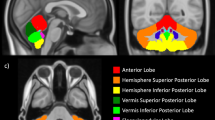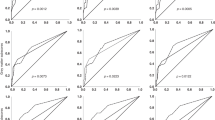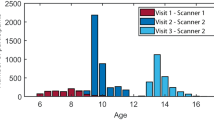Abstract
We have shown that cerebellar injury in the premature infant is followed by significant growth impairment of the contralateral cerebral hemisphere evident as early as term adjusted age. In this study, we hypothesize that this remote growth restriction is region specific in the cerebrum. In a prospectively enrolled cohort of 38 expreterm infants with isolated cerebellar injury by neonatal MRI, we performed follow-up volumetric MRI studies at a mean postnatal age of 35.5 ± 13.8 mo. We measured volumes of cortical and subcortical gray matter, and cerebral white matter within eight parcellated regions for each cerebral hemisphere. Unilateral cerebellar injury (n = 24) was associated with significantly smaller volumes of cortical gray and cerebral white matter in the following regions of the contralateral (versus ipsilateral) cerebral hemisphere: dorsolateral prefrontal, premotor (PM), sensorimotor, and midtemporal regions (p < 0.001 for all except midtemporal cortical gray, p = 0.01), as well as subcortical gray matter in the PM region (p < 0.001). Conversely, in cases of bilateral cerebellar injury (n = 14), there was no significant interhemispheric difference in tissue volumes for any of the cerebral regions studied. These findings suggest that regional cerebral growth impairment results from interruption of cerebellocerebral connectivity and loss of neuronal activation critical for development.
Similar content being viewed by others
Log in or create a free account to read this content
Gain free access to this article, as well as selected content from this journal and more on nature.com
or
Abbreviations
- DLPF:
-
dorsolateral prefrontal
- IO:
-
inferior occipital
- OF:
-
orbitofrontal
- PM:
-
premotor
- SG:
-
subgenual
- SM:
-
sensorimotor
- MT:
-
midtemporal
- PO:
-
parietooccipital
References
Volpe JJ 2008 Intracranial hemorrhage: Germinal matrix-intraventricular hemorrhage of the premature infant. Neurology of the Newborn. Saunders Elsevier, Philadelphia, pp 517–588
Volpe JJ 2009 Brain injury in premature infants: a complex amalgam of destructive and developmental disturbances. Lancet Neurol 8: 110–124
Limperopoulos C, Benson CB, Bassan H, Disalvo DN, Kinnamon DD, Moore M, Ringer SA, Volpe JJ, du Plessis AJ 2005 Cerebellar hemorrhage in the preterm infant: ultrasonographic findings and risk factors. Pediatrics 116: 717–724
Messerschmidt A, Fuiko R, Prayer D, Brugger PC, Boltshauser E, Zoder G, Sterniste W, Weber M, Birnbacher R 2008 Disrupted cerebellar development in preterm infants is associated with impaired neurodevelopmental outcome. Eur J Pediatr 167: 1141–1147
Bodensteiner JB, Johnsen SD 2005 Cerebellar injury in the extremely premature infant: newly recognized but relatively common outcome. J Child Neurol 20: 139–142
Limperopoulos C, Soul JS, Haidar H, Huppi PS, Bassan H, Warfield SK, Robertson RL, Moore M, Akins P, Volpe JJ, du Plessis AJ 2005 Impaired trophic interactions between the cerebellum and the cerebrum among preterm infants. Pediatrics 116: 844–850
Collins DL, Neelin P, Peters TM, Evans AC 1994 Automatic 3D intersubject registration of MR volumetric data in standardized Talairach space. J Comput Assist Tomogr 18: 192–205
Zijdenbos AP, Dawant BM 1994 Brain segmentation and white matter lesion detection in MR images. Crit Rev Biomed Eng 22: 401–465
Srinivasan L, Dutta R, Counsell SJ, Allsop JM, Boardman JP, Rutherford MA, Edwards AD 2007 Quantification of deep gray matter in preterm infants at term-equivalent age using manual volumetry of 3-tesla magnetic resonance images. Pediatrics 119: 759–765
Evans AC, Collins DL, Mills SR, Brown ED, Kelly RL, Peters TM 1993 3D statistical neuroanatomical models from 305 MRI volumes. Proc IEEE Nucl Sci Symp Med Imaging Conf 3: 1813–1817
Peterson BS, Vohr B, Staib LH, Cannistraci CJ, Dolberg A, Schneider KC, Katz KH, Westerveld M, Sparrow S, Anderson AW, Duncan CC, Makuch RW, Gore JC, Ment LR 2000 Regional brain volume abnormalities and long-term cognitive outcome in preterm infants. JAMA 284: 1939–1947
Limperopoulos C, Soul JS, Gauvreau K, Huppi PS, Warfield SK, Bassan H, Robertson RL, Volpe JJ, du Plessis AJ 2005 Late gestation cerebellar growth is rapid and impeded by premature birth. Pediatrics 115: 688–695
Pantano P, Baron JC, Samson Y, Bousser MG, Derouesne C, Comar D 1986 Crossed cerebellar diaschisis. Further studies. Brain 109: 677–694
Niimura K, Chugani DC, Muzik O, Chugani HT 1999 Cerebellar reorganization following cortical injury in humans: effects of lesion size and age. Neurology 52: 792–797
Miyazawa N, Toyama K, Arbab AS, Koizumi K, Arai T, Nukui H 2001 Evaluation of crossed cerebellar diaschisis in 30 patients with major cerebral artery occlusion by means of quantitative I-123 IMP SPECT. Ann Nucl Med 15: 513–519
Komaba Y, Mishina M, Utsumi K, Katayama Y, Kobayashi S, Mori O 2004 Crossed cerebellar diaschisis in patients with cortical infarction: logistic regression analysis to control for confounding effects. Stroke 35: 472–476
Yamauchi H, Fukuyama H, Nagahama Y, Nishizawa S, Konishi J 1999 Uncoupling of oxygen and glucose metabolism in persistent crossed cerebellar diaschisis. Stroke 30: 1424–1428
Sonmezoglu K, Sperling B, Henriksen T, Tfelt-Hansen P, Lassen NA 1993 Reduced contralateral hemispheric flow measured by SPECT in cerebellar lesions: crossed cerebral diaschisis. Acta Neurol Scand 87: 275–280
Gomez Beldarrain M, Garcia-Monco JC, Quintana JM, Llorens V, Rodeno E 1997 Diaschisis and neuropsychological performance after cerebellar stroke. Eur Neurol 37: 82–89
Komaba Y, Osono E, Kitamura S, Katayama Y 2000 Crossed cerebellocerebral diaschisis in patients with cerebellar stroke. Acta Neurol Scand 101: 8–12
Broich K, Hartmann A, Biersack HJ, Horn R 1987 Crossed cerebello-cerebral diaschisis in a patient with cerebellar infarction. Neurosci Lett 83: 7–12
Hausen HS, Lachmann EA, Nagler W 1997 Cerebral diaschisis following cerebellar hemorrhage. Arch Phys Med Rehabil 78: 546–549
Sagiuchi T, Ishii K, Aoki Y, Kan S, Utsuki S, Tanaka R, Fujii K, Hayakawa K 2001 Bilateral crossed cerebello-cerebral diaschisis and mutism after surgery for cerebellar medulloblastoma. Ann Nucl Med 15: 157–160
Allen G, McColl R, Barnard H, Ringe WK, Fleckenstein J, Cullum CM 2005 Magnetic resonance imaging of cerebellar-prefrontal and cerebellar-parietal functional connectivity. Neuroimage 28: 39–48
Middleton FA, Strick PL 2001 Cerebellar projections to the prefrontal cortex of the primate. J Neurosci 21: 700–712
Kelly RM, Strick PL 2003 Cerebellar loops with motor cortex and prefrontal cortex of a nonhuman primate. J Neurosci 23: 8432–8444
Stoodley CJ, Schmahmann JD 2009 Functional topography in the human cerebellum: a meta-analysis of neuroimaging studies. Neuroimage 44: 489–501
Rollins NK, Wen TS, Dominguez R 1995 Crossed cerebellar atrophy in children: a neurologic sequela of extreme prematurity. Pediatr Radiol 25: S20–S25
Limperopoulos C, Bassan H, Gauvreau K, Robertson RL Jr, Sullivan NR, Benson CB, Avery L, Stewart J, Soul JS, Ringer SA, Volpe JJ, duPlessis AJ 2007 Does cerebellar injury in premature infants contribute to the high prevalence of long-term cognitive, learning, and behavioral disability in survivors?. Pediatrics 120: 584–593
Schmahmann JD 2004 Disorders of the cerebellum: ataxia, dysmetria of thought, and the cerebellar cognitive affective syndrome. J Neuropsychiatry Clin Neurosci 16: 367–378
Acknowledgements
We thank Shaye Moore for assistance with manuscript preparation and the children and families for their participation in this study.
Author information
Authors and Affiliations
Corresponding author
Additional information
Supported by the Hearst Foundation, the LifeBridge Fund, the Caroline Levine Foundation, the Trust Family Foundation, the National Institutes of Health (NINDS K24NS057568, A.J.P.), and the Canada Research Chairs Program, Canada Research Chair in Brain and Development Tier 2 (C.L.).
Rights and permissions
About this article
Cite this article
Limperopoulos, C., Chilingaryan, G., Guizard, N. et al. Cerebellar Injury in the Premature Infant Is Associated With Impaired Growth of Specific Cerebral Regions. Pediatr Res 68, 145–150 (2010). https://doi.org/10.1203/PDR.0b013e3181e1d032
Received:
Accepted:
Issue date:
DOI: https://doi.org/10.1203/PDR.0b013e3181e1d032
This article is cited by
-
Cerebellar contributions to a brainwide network for flexible behavior in mice
Communications Biology (2023)
-
Glutamatergic cerebellar neurons differentially contribute to the acquisition of motor and social behaviors
Nature Communications (2023)
-
The shifting role of the cerebellum in executive, emotional and social processing across the lifespan
Behavioral and Brain Functions (2022)
-
Cerebellar volumes and language functions in school-aged children born very preterm
Pediatric Research (2021)
-
Structural Changes in the Cortico-Ponto-Cerebellar Axis at Birth are Associated with Abnormal Neurological Outcomes in Childhood
Clinical Neuroradiology (2021)



